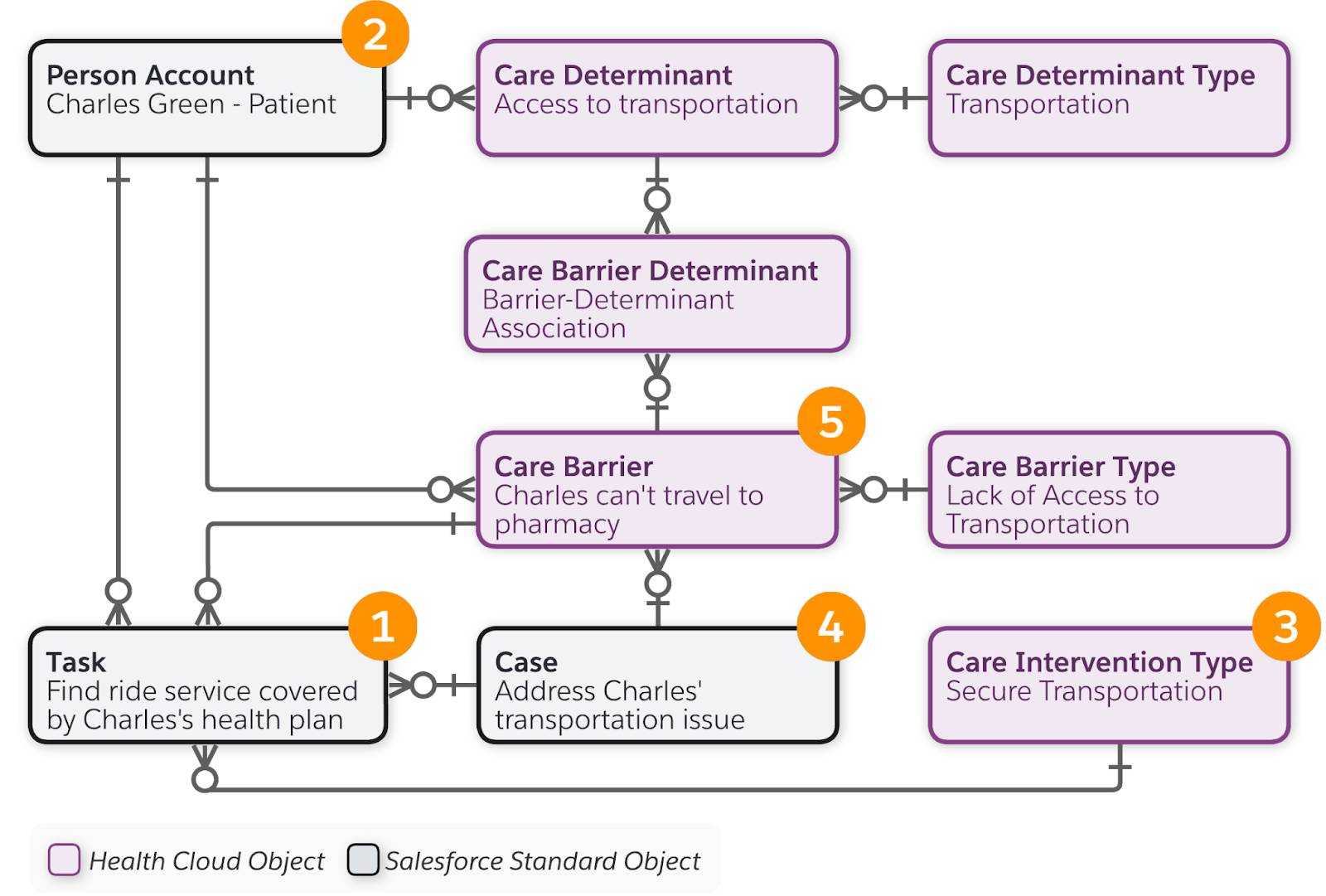Discover the Social Determinants of Health Data Model
Learning Objectives
After completing this unit, you’ll be able to:
- Explain the purpose of the social determinants of health data model.
- Describe the objects for care determinants.
- Describe the objects for care barriers.
- Describe the objects for care intervention.
The Social Determinants of Health Data Model
Social determinants of health (SDOH) are the critical social and environmental factors that may become barriers to a patient’s or member’s wellness. The Social Determinants data model helps you gain insight into the physical environment and socioeconomic status of a patient so that you gain a holistic perspective on these factors. This helps you identify intervention tasks to address care barriers and reduce health setbacks for patients and members.
A common SDOH example is food insecurity. When patients and members don’t have an adequate number of meals or snacks daily, or the quality of their meals is poor, this can lead to higher-than-average visits to the emergency room. The intervention is to provide access to affordable nutritious food via food debit cards, food banks, food delivery services, farmers markets, and subsidized meal programs.
Another common example is lack of access to transportation, which we’ll cover in this unit.
When Charles Green enrolls in the pain management care program, the program team sends him a survey to proactively address potential risks or challenges that affect his health outcomes.
A survey question asks whether Charles has access to transportation. Because patients can struggle to get to pharmacies to pick up their medication or go to appointments to receive important care, access to transportation is a social determinant of health. Lack of transportation is a care barrier to this determinant.
Charles responds that he doesn’t have a car and he can’t pick up his prescriptions on time.

The care program team logs a case to address Charles’s transportation issue. To resolve the case, the team’s task is to find a transportation service covered by Bloomington Health Plans, Charles’s health insurance payer.
Let’s first examine the objects that represent care determinants.
Care Determinants
Access to transportation is considered a social determinant of health.

Here’s a summary of the objects and records.
Scenario Details |
Object and Record Details |
|---|---|
Access to transportation is a social determinant of health. |
Care Determinant (1) represents the social determinants of health for a patient such as availability of safe housing, adequate employment, transportation, or local food markets. A care determinant record references the patient record (2) and a care determinant type record (3). |
Transportation is a care determinant type. |
Care Determinant Type (3) represents a library of standard, predefined determinants that an organization maintains. For example, predefined care determinants include Income and Housing. |
Next, let’s examine the objects that represent care barriers.
Care Barriers
Charles doesn’t have a car and he can’t pick up his prescriptions from the pharmacy on time. (The pharmacy could mail him the prescriptions of course but for the purposes of this example, let’s assume this isn’t possible in Charles’s situation. A lack of a delivery address could also be a care barrier in this scenario.)

Here’s a summary of the objects and records.
Scenario Details |
Object and Record Details |
|---|---|
Charles doesn’t have a car and he can’t pick up his prescriptions on time. |
Care Barrier (1) represents the circumstances or obstacles affecting a patient or member such as lack of housing, employment, transportation, or access to food. A care barrier record references the patient record (2) and a care barrier type record (3). |
Lack of transportation is a care barrier type. |
Care Barrier Type (3) represents a library of standard, predefined barriers that an organization maintains. For example, predefined care barriers include Low income and Lack of Housing. |
Lack of transportation is considered a care barrier to the access to transportation determinant. |
Care Barrier Determinant (4) represents the relationship of a care barrier (1) to a care determinant (5). For example, a patient's lack of transportation is a care barrier that relates to the Transportation care determinant. A care barrier determinant record references a care determinant record and a care barrier record. |
Finally, let’s examine the objects that represent care intervention.
Care Interventions
The care program team logs a case to address Charles’s transportation issue. To resolve the case, the team’s task is to find a transportation service.

Here’s a summary of the objects.
Scenario Details |
Object and Record Details |
|---|---|
The team must find a transportation service covered by Charles’s plan with Bloomington Health Plans, his health insurance payer. |
Task (1) represents the efforts made by the team to resolve case barriers. A task record references the patient record (2), a care intervention type record (3), a case record (4), and a care barrier record (5). |
Find transportation is a care intervention type. |
Care Intervention Type (3) represents the standard, defined list of interventions that an organization maintains. For example, Find Transportation is an intervention type for the Lack of transportation care barrier. |
The Good Health Pharma care program team logs a case to address Charles’s transportation issue. |
Case (4) represents a patient issue or problem. |
By finding transportation for Charles, the care program team helps him overcome his transportation barrier. He’s back on track on his journey to better health.
For more details about the objects we introduced in this unit, see the Salesforce Health Cloud Developer Guide.
In the next unit, learn how the provider data model makes it possible for members, patients, and organizations to find the right provider in the right network.
Resources